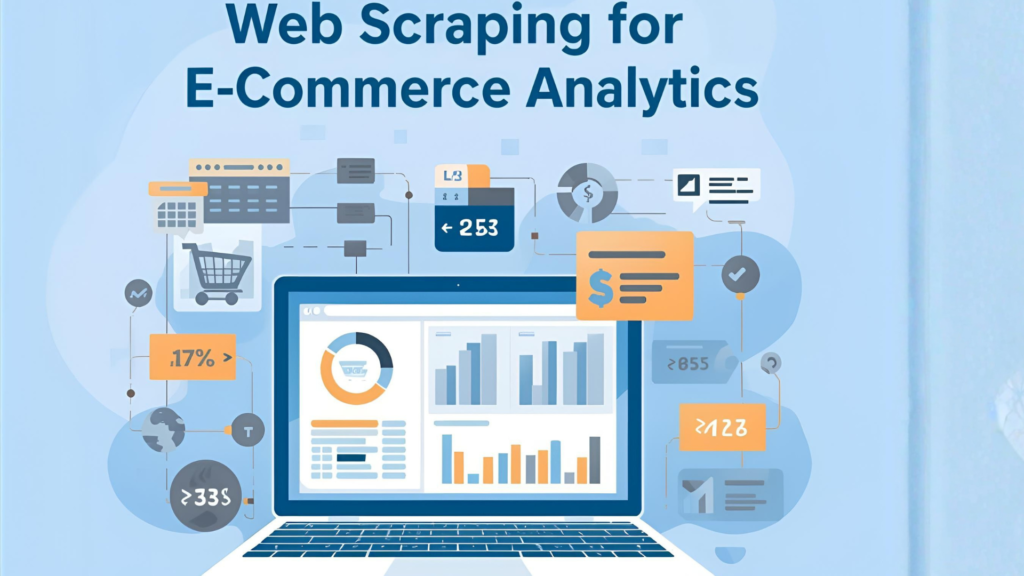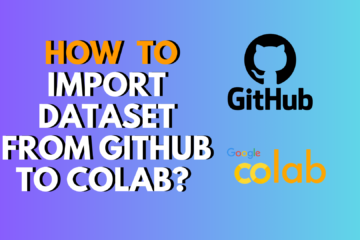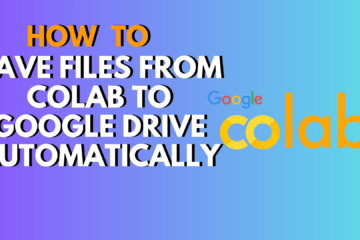
In 2025, data is the new currency for every e-commerce business. Whether you’re an entrepreneur, analyst, or data scientist, understanding how to extract, analyze, and interpret real-time data from competitors and markets gives you a massive edge.
One of the most powerful ways to gather this data is through web scraping — the automated extraction of information from websites. In this comprehensive guide, you’ll learn how to build a web scraping project for e-commerce analytics, complete with dataset creation, Python code examples, step-by-step process, and advanced insights.
🧭 Table of Contents
- What Is Web Scraping for E-Commerce Analytics?
- Why It’s Crucial in 2025
- Project Overview & Goals
- Dataset Structure Example
- Step-by-Step Implementation
- 5.1 Environment Setup
- 5.2 Target Website Selection
- 5.3 HTML Structure Analysis
- 5.4 Data Extraction with BeautifulSoup & Requests
- 5.5 Data Cleaning and Storage
- 5.6 Analytical Use Cases
- Case Study: Price & Rating Trends from Amazon
- Visual Insights and Dashboards
- Comparison Table: Tools & Libraries
- FAQs
- Conclusion & Call to Action
🧩 1. What Is Web Scraping for E-Commerce Analytics?
Web scraping refers to extracting publicly available data from websites using automated scripts or crawlers.
In the context of e-commerce analytics, it helps businesses collect real-time data such as:
- Product names, prices, and discounts
- Customer ratings and reviews
- Availability and stock information
- Competitor trends
- Seller details and product descriptions
By analyzing this data, businesses can optimize pricing, predict trends, and improve their competitive positioning.
💻 Python for Data Analysis — Learn how to use Python for analytics, visualization, and automation in real-world tech projects
🚀 2. Why It’s Crucial in 2025
In 2025, the e-commerce landscape is more dynamic than ever:
- AI-driven marketplaces adjust prices hourly.
- Dynamic promotions and flash sales dominate.
- Customer reviews directly influence conversions.
- Competitor monitoring is vital for market agility.
With web scraping, you can automate the collection of actionable insights — eliminating guesswork and relying on real-time evidence.
🎯 3. Project Overview & Goals
Objective:
Build a Python-based web scraping project that collects and analyzes real-time product data from e-commerce websites to understand pricing, ratings, and trends.
Key Goals:
- Extract structured product data (titles, prices, ratings).
- Store and clean the data for analysis.
- Visualize insights using Python dashboards or BI tools.
- Enable trend tracking and competitor comparison.
📊 4. Dataset Structure Example
Once you extract data, your dataset might look like this:
| Product_ID | Product_Name | Price | Rating | Reviews | Availability | Category | URL | Scrape_Date |
|---|---|---|---|---|---|---|---|---|
| P001 | Wireless Headphones | 89.99 | 4.6 | 1543 | In Stock | Electronics | amazon.com/… | 2025-10-25 |
| P002 | Smartwatch Pro | 129.50 | 4.3 | 987 | In Stock | Electronics | amazon.com/… | 2025-10-25 |
| P003 | Portable Charger | 29.90 | 4.7 | 3456 | Out of Stock | Accessories | amazon.com/… | 2025-10-25 |
This table is perfect for price monitoring, sentiment analysis, and trend forecasting.
🧰 5. Step-by-Step Implementation
Let’s walk through how to build this project in Python.
5.1 Environment Setup
Install required libraries:
pip install requests beautifulsoup4 pandas lxml matplotlib
5.2 Target Website Selection
Choose a publicly accessible website for data extraction (e.g., Kaggle’s e-commerce datasets, or sample product pages like books.toscrape.com).
⚠️ Important: Always check a website’s robots.txt file and terms of service before scraping. Avoid violating privacy or copyright laws.
5.3 HTML Structure Analysis
Open your target page → right-click → Inspect Element → check HTML tags of price, title, rating, etc.
Example HTML snippet:
<div class="product-item">
<h2 class="title">Wireless Headphones</h2>
<span class="price">$89.99</span>
<div class="rating">4.6</div>
</div>
5.4 Data Extraction with BeautifulSoup
import requests
from bs4 import BeautifulSoup
import pandas as pd
url = "https://books.toscrape.com/catalogue/category/books_1/index.html"
response = requests.get(url)
soup = BeautifulSoup(response.text, "lxml")
titles = [item.h3.a['title'] for item in soup.find_all("article", class_="product_pod")]
prices = [item.find("p", class_="price_color").text[1:] for item in soup.find_all("article", class_="product_pod")]
ratings = [item.p['class'][1] for item in soup.find_all("article", class_="product_pod")]
df = pd.DataFrame({"Title": titles, "Price (£)": prices, "Rating": ratings})
df.to_csv("ecommerce_data.csv", index=False)
print(df.head())
✅ Output Sample:
| Title | Price (£) | Rating |
|---|---|---|
| A Light in the Attic | 51.77 | Three |
| Tipping the Velvet | 53.74 | One |
| Soumission | 50.10 | One |
5.5 Data Cleaning and Storage
Convert prices to numeric values and clean missing data:
df["Price (£)"] = df["Price (£)"].astype(float)
df["Rating"] = df["Rating"].map({
"One": 1, "Two": 2, "Three": 3, "Four": 4, "Five": 5
})
df.dropna(inplace=True)
Store in CSV, database, or cloud (Google Sheets, MongoDB).
5.6 Analytical Use Cases
Once you’ve built your dataset, explore:
- Average prices by category
- Top-rated products
- Price distribution
- Correlation between price and rating
import matplotlib.pyplot as plt
plt.hist(df["Price (£)"], bins=20)
plt.title("Product Price Distribution")
plt.xlabel("Price (£)")
plt.ylabel("Frequency")
plt.show()
📈 6. Case Study: Price & Rating Trends from Amazon
Imagine scraping 1,000+ product listings from Amazon across multiple categories weekly.
After cleaning and analyzing, you find:
- Average price increased by 7% in Q3 2025.
- Ratings slightly dropped for “Smartwatches,” signaling user dissatisfaction.
- Discounted products got 23% more reviews, proving higher engagement.
With these insights, an e-commerce brand can adjust pricing strategies, discount timing, and quality control decisions — all powered by scraped data.
🧮 7. Visual Insights and Dashboards
Visual dashboards amplify insights. Consider tools like:
- Power BI or Tableau for interactive dashboards.
- Plotly Dash or Streamlit for Python web apps.
Include visuals such as:
- Price trend line chart
- Top categories bar chart
- Ratings heatmap
- Product sentiment word cloud
💡 Visual Suggestion:
A comparison graph of “Average Price vs Average Rating” per category to identify pricing sweet spots.
⚙️ 8. Comparison Table: Tools & Libraries
| Task | Library / Tool | Description |
|---|---|---|
| Web Requests | requests | Fetches HTML content from URLs |
| Parsing HTML | BeautifulSoup, lxml | Extracts and navigates data from HTML |
| Dynamic Pages | Selenium, Playwright | Automates JS-heavy sites |
| Storage | Pandas, SQLite, MongoDB | Saves and manipulates datasets |
| Visualization | Matplotlib, Plotly, Power BI | Creates graphs and dashboards |
| Scheduling | cron, Airflow | Automates scraping jobs |
Other Projects with Codes
🧠 Computer Engineering Projects — Discover innovative ideas for AI, IoT, and embedded systems on our Computer Engineering Projects page
💻 Python for Data Analysis — Learn how to use Python for analytics, visualization, and automation in real-world tech projects
💬 9. Frequently Asked Questions (FAQ)
Q1: Is web scraping legal?
✅ Yes, if you collect public data responsibly and comply with a site’s robots.txt policy. Avoid scraping personal or copyrighted data.
Q2: Can I scrape sites like Amazon or eBay?
You can, but they often have rate limits and anti-bot systems. Use APIs (like Amazon Product Advertising API) when available.
Q3: How to avoid being blocked?
Use headers rotation, random delays, and proxies (responsibly). Limit scraping frequency.
Q4: What’s the best tool for large-scale scraping?Scrapy or Playwright for scalable and complex scraping pipelines.
Q5: How can scraped data help my business?
You can benchmark pricing, track competitors, detect fake reviews, and identify trending products before they peak.
🏁 10. Conclusion & Call to Action
In today’s data-driven era, web scraping for e-commerce analytics is a game-changer.
By automating the collection of market data, you gain insights into pricing strategies, product trends, and customer behavior — all in real time.
To recap:
- Choose your target source responsibly.
- Extract structured product data using Python.
- Clean, analyze, and visualize insights.
- Automate scraping for continuous intelligence.
💡 Next Steps:
- Try scraping data from an open-source e-commerce site like books.toscrape.com.
- Build your first dashboard using Plotly or Power BI.
- Explore our Data Analytics Tutorials for deeper insights.
📢 Don’t forget to share this article with your peers and tag us when you publish your own scraping results!




0 Comments